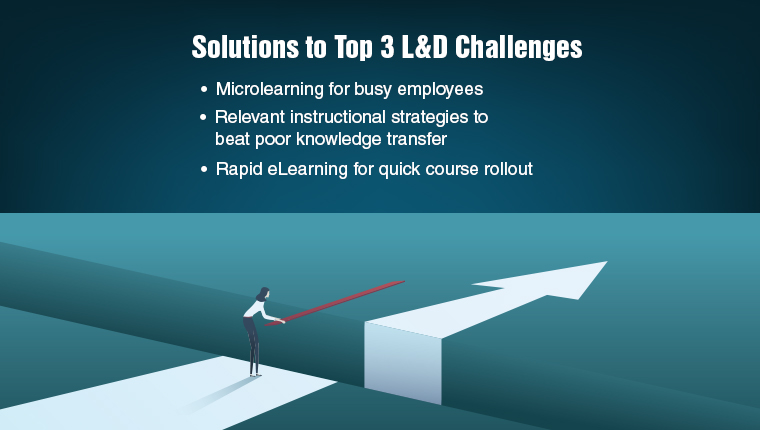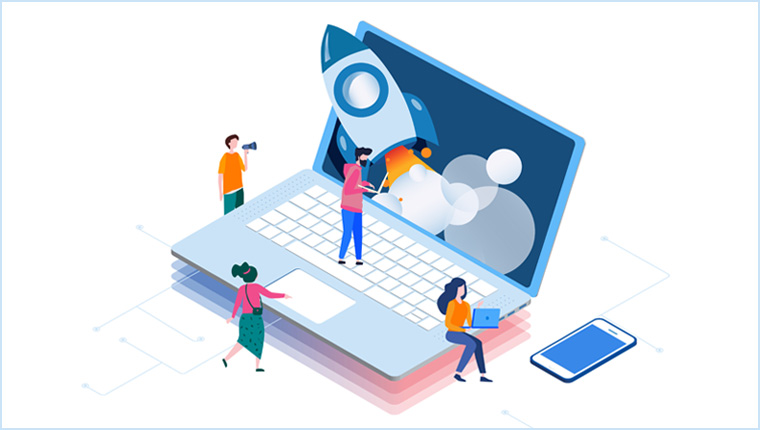Top 3 L&D Challenges and Online Training Solutions

Across all global organizations, the number one challenge L&D professionals face is maintaining the effectiveness of the corporate training program. Yet despite careful strategizing, resource allocation, and planning, many online training programs still land in trouble—either poor content renders the training disengaging, or a new tech/trend comes along to disrupt the seemingly peaceful training program.
The 3 Biggest L&D Challenges—and their Online Solutions
Busy ‘Modern’ Employees Have No Time for Training
- Consider implementing microlearning
- Enable anytime anywhere learning with responsive learning
Low Engagement Levels and Poor Knowledge Transfer
- Communicate the performance-based learning outcomes upfront
- Use good instructional strategies to establish relevance
- Beat the Forgetting Curve with JIT & refresher courses
Training Development on a Budget
- Choose rapid e-learning for cost-effective rollout
- Consider outsourcing
But as the old adage goes “the only constant is change”, and this couldn’t be truer about today’s corporate training. L&D departments are required to be on their toes to identify and solve every training challenge they lay their eyes on. In this blog, we will look at the three most common challenges L&D departments are likely to face and try to understand how each of them can be tackled head-on.
3 Biggest L&D Challenges—and How to Solve Them
1. Busy ‘Modern’ Employees Have No Time for Training
Technology may have made it easier to deliver training materials quickly, but we are yet to create more time for employees to consume them. The pace at which today’s cutthroat corporate environment thrives means learning has been pushed to the wayside. Employees have hectic work schedules and expecting them to take time to attend hour-long traditional training is a bit unfair.
How to deal with this time crunch? Here are some possible solutions to the problem.
Consider Implementing a Microlearning Strategy
Microlearning is learning in small modules of around 5-10 minutes, with each module covering a single learning outcome. With microlearning modules, you can offer learners just the relevant, need-to-know information. These modules can be made mobile-friendly, meaning employees can access the training content at their own convenience.
Microlearning can also be implemented in a variety of formats such as standalone micro courses, or in the form of infographics, interactive PDFs, short animated videos, and whiteboard animations that make training easier to consume.
Download a handy guide on getting started with microlearning.
Make Anytime-Anywhere Learning Easy with Responsive Learning
As the workforce gets saturated with millennials—who prefer learning on the go, on their mobile devices—adapting to this learning demand will become a necessity rather than an option.
Responsive design enables companies to make training content available on Android smartphones and tablets, iPhones, iPads, laptops, and desktops. It provides increased access and use by a broader populace. This kind of multi-device access is important to the millennials in today’s workforce, who have grown up with mobile devices and are increasingly comfortable with, and often prefer, learning on the go.
Responsive courses, when hosted on an LMS, make it easy for learners to access the training materials anywhere, any time – including while commuting to work, or whenever they find time between breaks. Training is not a one-time event—knowledge and skills need to be reinforced over time. For this, offer courses to learners in spaced intervals as opposed to cramming up everything into one session. Doing so will also help them reflect and retain the information over a long period of time.
2. Low Engagement Levels and Poor Knowledge Transfer
One of the factors that determines the effectiveness of the training program is knowledge transfer—how much learning the learners are able to retain and apply to their jobs. For training to be effective, content must be engaging and relevant to the learner.
Engaged learners are more likely to retain the knowledge and apply it on their jobs to tackle work challenges. On the other hand, poorly designed content with no relevance to learners’ jobs can lead to them mentally resisting engagement. Lower engagement levels impact their knowledge retention levels and, as a result, very less knowledge transfer takes place.
All said and done, boosting engagement for better knowledge transfer must occur on multiple levels including behavioral, emotional, and cognitive. Without any of them in place, training is only going to come across as passive. Here are some useful ways to improve and boost engagement and knowledge transfer.
Communicate the Performance-based Learning Outcomes Upfront
Learners tend to put in more effort to learn and stick to the training if they are told upfront how the learning will help them tackle their work challenges. Set clear performance-based learning objectives right at the beginning of the course and capture their attention from the word go. State what the learner will be able to do, how the training will improve their work performance.
| A Pro Tip
Instead of plainly stating the learning objectives, spice up things a little by putting learners to work immediately on a task before the training even begins. Provide adequate, but minimal amount of instruction so learners can show what they know, what they can and cannot do, almost immediately. This way, when learners try and fail, they will know what they are going to be able to do when they finish the learning. |
Use Good Instructional Strategies to Establish Relevance
Instructional strategies are the bedrock of any training. They are techniques instructional designers use to teach/present a subject or a concept to learners. There are many instructional design strategies out there that can help you maximize learner engagement and improve transfer of knowledge. Some examples include:
- Scenario-based learning
- Learning through Exploration and Discovery (LEAD)
- Storytelling
- Game-based learning
For example, scenario-based learning (SBL) involves learners working their way through a storyline, usually based around a complex challenge/problem, which they are required to solve. In the process, learners are required to apply their knowledge regarding the subject, applying their problem-solving skills in a safe, real-world context.
Beat the Forgetting Curve with JIT & Refresher Courses
A major cause of concern for many L&D professionals is their learners falling victims to the forgetting curve—rapid loss of memory of learned knowledge in a matter of days or weeks, unless the information is consciously reviewed. If you wish to help learners beat the forgetting curve and retain knowledge for long-term application, ensure you reinforce knowledge even after the training concludes.
Offer regular refresher courses after the training concludes. Because of the smaller interval of time between the learning session and the application of that learning, greater is the possibility of learners succeeding in transferring skills to that situation.
Also, when learners need urgent information to finish a job task, there may not be enough time to sit through an entire training session just to access the required information. In such cases, provide just-in-time (performance) support – which is all about giving learners the right information at the moment of need. Use microlearning assets such as infographics, PDFs, videos, and whiteboard animations that provide easy-to-digest information.
3. Training Development on a Budget
What further contributes to challenges for L&D departments is when they need to develop training within a strained budget. If training budgets tend to be small and yet training needs to be delivered at breakneck speed, what do you do? Creating courses from scratch is a time-consuming and costly affair when training has to be quick. For such cases, rapid eLearning is a game-changer.
Choose Rapid E-learning for Cost-effective Rollout
Rapid eLearning refers to the process of quick eLearning development using rapid authoring tools—such as Articulate Storyline, Adobe Captivate, and Lectora Inspire, to name a few. The tools come with built-in templates and media libraries, which means you do not have to create courses from scratch. Designers can choose to customize these templates according to your training needs to achieve the required learning outcomes.
As the training development progresses, some components are likely to become standardized, so one template can be reused multiple times. You can create an e-library of reusable templates to ensure a consistent format, all while increasing the return on investment and reducing the cost of development.
Having said that, rapid eLearning does not mean you have to settle for a training solution that compromises on the quality. Although authoring tools are instrumental in drastically reducing development time and costs, you still require instructional designers to make the courses engaging and impactful. They cut out any and all unnecessary frills that serve no instructional purpose in the course, focusing just on implementing strong instructional design principles.
Consider Outsourcing
As an L&D professional, you ought to ensure your internal team has the required instructional design expertise and is capable of using the rapid authoring tools to deliver high-impact training—for a partially-skilled internal team is only going to add to the overall costs and time. Then the only option is to outsource course development to an eLearning vendor, who will:
- Have a pool of experts in instructional design and authoring tools
- Have good project management processes to scale up (or down) eLearning development
- Offer add-on services such as translations
Concluding Remarks
There you have it. These are the three big challenges that are likely to keep L&D professionals from creating a robust employee training program. But taking cognizance of the available technology-based solutions I’ve discussed in the blog can really help tackle the challenges head-on.
No matter the size of your organization, employee training remains a crucial deciding-factor in achieving sustained success, and gaining a competitive edge in the market. For achieving better results with their training, many organizations choose to outsource the training development process. Here’s a great resource on outsourcing, the benefits of outsourcing and tips on how to pick a good outsourcing vendor.





